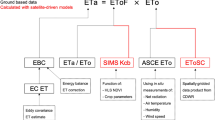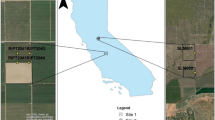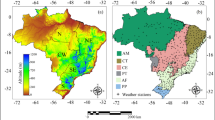Abstract
Sustainable use of available water resources in viticulture can be aided by frequent high-resolution information on vineyard water status. Recently, a new Shuttleworth–Wallace evapotranspiration (ET) model, which uses a contextual framework to determine dry and wet extremes from the Sentinel-2 surface reflectance data (SW-S2), showed promising results when tested over a GRAPEX (Grape Remote-sensing Atmospheric Profile and ET eXperiment) site in California. However, current knowledge on its applicability across the climate gradient in California and how the selections of modeling domain and meteorological data influence model outputs are limited. This study expands the evaluation of the SW-S2 model across multiple domains and meteorological inputs covering all three GRAPEX sites over the 2018–2020 growing seasons. In comparison with flux tower observations, the size of the modeling domain did not have a strong influence on model performance, although the model performed marginally better under a larger domain (yielding root mean square error within 1.03–1.11 mm d−1 and mean biases within 2%). The source and quality of meteorological forcing data, in particular vapor pressure deficit (VPD) and wind speed (u), were found to have a strong influence on model output as indicated by the poor performance of the model with less accurate regional and coarse-scale gridded meteorological inputs. Results suggest that simple regression for local bias correction of VPD and u significantly improved model performance. Overall, this study supports future research aiming to merge outputs from more frequent spectral and less frequent thermal-based ET models and reduce latency in ET monitoring of California vineyards.









Similar content being viewed by others
References
Abatzoglou JT (2013) Development of gridded surface meteorological data for ecological applications and modelling. Int J Climatol 33:121–131
Allen RG, Pereira LS, Raes D, Smith M (1998) Crop evapotranspiration-Guidelines for computing crop water requirements-FAO Irrigation and drainage paper 56. FAO, Rome 300:D05109
Allen RG, Tasumi M, Trezza R (2007) Satellite-based energy balance for map** evapotranspiration with internalized calibration (METRIC) - Model. J Irrig Drain Eng 133:380–394
Allen RG, Pereira LS, Howell TA, Jensen ME (2011) Evapotranspiration information reporting: I. Factors governing measurement accuracy. Agric Water Manag 98:899–920
Allen RG, Dhungel R, Dhungana B, Huntington J, Kilic A, Morton C (2021) Conditioning point and gridded weather data under aridity conditions for calculation of reference evapotranspiration. Agric Water Manag 245:106531
Anderson MC, Allen RG, Morse A, Kustas WP (2012) Use of Landsat thermal imagery in monitoring evapotranspiration and managing water resources. Remote Sens Environ 122:50–65
Anderson M, Diak G, Gao F, Knipper K, Hain C, Eichelmann E, Hemes KS, Baldocchi D, Kustas W, Yang Y (2019) Impact of insolation data source on remote sensing retrievals of evapotranspiration over the California. Delta 11:216
Anderson MC, Norman JM, Mecikalski JR, Otkin JA, Kustas WP (2007) A climatological study of evapotranspiration and moisture stress across the continental United States based on thermal remote sensing: 1. Model formulation. J Geophys Res Atmos. https://doi.org/10.1029/2006JD007506
Anderson MC, Yang Y, Xue J, Knipper KR, Yang Y, Gao F, Hain CR, Kustas WP, Cawse-Nicholson K, Hulley G, Fisher JB, Alfieri JG, Meyers TP, Prueger J, Baldocchi DD, Rey-Sanchez C (2021) Interoperability of ECOSTRESS and Landsat for map** evapotranspiration time series at sub-field scales. Remote Sens Environm 252:112189
Bellvert J, Jofre-Ĉekalović C, Pelechá A, Mata M, Nieto H (2020) Feasibility of Using the Two-Source Energy Balance Model (TSEB) with Sentinel-2 and Sentinel-3 Images to Analyze the Spatio-Temporal Variability of Vine Water Status in a Vineyard. Remote Sens 12:2299
Bhattarai N, Shaw SB, Quackenbush LJ, Im J, Niraula R (2016) Evaluating five remote sensing based single-source surface energy balance models for estimating daily evapotranspiration in a humid subtropical climate. Int J Appl Earth Obs Geoinf 49:75–86
Bhattarai N, Mallick K, Stuart J, Vishwakarma BD, Niraula R, Sen S, Jain M (2019) An automated multi-model evapotranspiration map** framework using remotely sensed and reanalysis data. Remote Sens Environ 229:69–92
Brutsaert W (1982) Evaporation in the atmosphere. D Reidel
Cammalleri C, Anderson M, Kustas W (2014) Upscaling of evapotranspiration fluxes from instantaneous to daytime scales for thermal remote sensing applications. Hydrol Earth Syst Sci 18:1885–1894
Campos I, Neale CMU, Calera A, Balbontín C, González-Piqueras J (2010) Assessing satellite-based basal crop coefficients for irrigated grapes (Vitis vinifera L.). Agric Water Manag 98:45–54
Carrasco-Benavides M, Ortega-Farias S, Lagos LO, Kleissl J, Morales L, Poblete-Echeverria C, Allen RG (2012) Crop coefficients and actual evapotranspiration of a drip-irrigated Merlot vineyard using multispectral satellite images. Irrig Sci 30:485–497
Chirouze J, Boulet G, Jarlan L, Fieuzal R, Rodriguez JC, Ezzahar J, Er-Raki S, Bigeard G, Merlin O, Garatuza-Payan J, Watts C, Chehbouni G (2014) Intercomparison of four remote-sensing-based energy balance methods to retrieve surface evapotranspiration and water stress of irrigated fields in semi-arid climate. Hydrol Earth Syst Sci 18:1165–1188
Cleveland WS (1981) LOWESS: A program for smoothing scatterplots by robust locally weighted regression. Am Stat 35:54
Collatz GJ, Ball JT, Grivet C, Berry JA (1991) Physiological and environmental regulation of stomatal conductance, photosynthesis and transpiration: a model that includes a laminar boundary layer. Agric For Meteorol 54:107–136
D’Urso G, Bolognesi SF, Kustas WP, Knipper KR, Anderson MC, Alsina MM, Hain CR, Alfieri JG, Prueger JH, Gao F, McKee LG, De Michele C, McElrone AJ, Bambach N, Sanchez L, Belfiore OR (2021) Determining evapotranspiration by using combination equation models with sentinel-2 data and comparison with thermal-based energy balance in a California irrigated Vineyard. Remote Sens 13:3720
DWR (2020). Statewide Crop Map**. In
García-Gutiérrez V, Stöckle C, Gil PM, Meza FJJRS (2021) Evaluation of penman-monteith model based on sentinel-2 data for the estimation of actual evapotranspiration in Vineyards. Remote Sense 13:478
Gelaro R, McCarty W, Suárez MJ, Todling R, Molod A, Takacs L, Randles CA, Darmenov A, Bosilovich MG, Reichle R, Wargan K, Coy L, Cullather R, Draper C, Akella S, Buchard V, Conaty A, Silva AMD, Gu W, Kim G-K, Koster R, Lucchesi R, Merkova D, Nielsen JE, Partyka G, Pawson S, Putman W, Rienecker M, Schubert SD, Sienkiewicz M, Zhao B (2017) The modern-era retrospective analysis for research and applications, version 2 (MERRA-2). J Climate 30:5419–5454
Di Gennaro SF, Dainelli R, Palliotti A, Toscano P, Matese AJRS (2019) Sentinel-2 validation for spatial variability assessment in overhead trellis system viticulture versus UAV and agronomic data. Remote Sense 11:2573
Guzinski R, Nieto H, Sandholt I, Karamitilios G (2020) Modelling high-resolution actual evapotranspiration through sentinel-2 and sentinel-3 data fusion. Remote Sense 12:1433
Hamlet AF, Lettenmaier DP (2005) Production of temporally consistent gridded precipitation and temperature fields for the continental United States. J Hydrometeorol 6:330–336
Hansen J, Johnson D, Lacis A, Lebedeff S, Lee P, Rind D, Russell G (1981) Climate impact of increasing atmospheric carbon dioxide. Science 213:957–966
He Y, Monahan AH, Jones CG, Dai A, Biner S, Caya D, Winger K (2010) Probability distributions of land surface wind speeds over North America. J Geophy Res Atmos. https://doi.org/10.1029/2008JD010708
Homer C, Dewitz J, ** S, **an G, Costello C, Danielson P, Gass L, Funk M, Wickham J, Stehman S, Auch R, Riitters K (2020) Conterminous United States land cover change patterns 2001–2016 from the 2016 National Land Cover Database. ISPRS J Photogramm Remote Sens 162:184–199
Jarvis P (1976) The interpretation of the variations in leaf water potential and stomatal conductance found in canopies in the field. Philos Trans Royal Soc London B Biol Sci 273:593–610
Jiang L, Islam S (1999) A methodology for estimation of surface evapotranspiration over large areas using remote sensing observations. Geophys Res Lett 26:2773–2776
Knipper KR, Kustas WP, Anderson MC, Alfieri JG, Prueger JH, Hain CR, Gao F, Yang Y, McKee LG, Nieto H, Hipps LE, Alsina MM, Sanchez L (2019a) Evapotranspiration estimates derived using thermal-based satellite remote sensing and data fusion for irrigation management in California vineyards. Irrig Sci 37:431–449
Knipper KR, Kustas WP, Anderson MC, Alsina MM, Hain CR, Alfieri JG, Prueger JH, Gao F, McKee LG, Sanchez LA (2019b) Using high-spatiotemporal thermal satellite ET retrievals for operational water use and stress monitoring in a California Vineyard. Remote Sense 11:2124
Knipper KR, Kustas WP, Anderson MC, Nieto H, Alfieri JG, Prueger JH, Hain CR, Gao F, McKee LG, Alsina MM, Sanchez L (2020) Using high-spatiotemporal thermal satellite ET retrievals to monitor water use over California vineyards of different climate, vine variety and trellis design. Agric Water Manag 241:106361
Kustas WP, Anderson MC, Alfieri JG, Knipper K, Torres-Rua A, Parry CK, Nieto H, Agam N, White WA, Gao F, McKee L, Prueger JH, Hipps LE, Los S, Alsina MM, Sanchez L, Sams B, Dokoozlian N, McKee M, Jones S, Yang Y, Wilson TG, Lei F, McElrone A, Heitman JL, Howard AM, Post K, Melton F, Hain C (2018) The grape remote sensing atmospheric profile and evapotranspiration experiment. J Bull Am Meteorol Soc 99:1791–1812
Kustas W, Norman J (1996) Use of remote sensing for evapotranspiration monitoring over land surfaces. Hydrol Sci J 41:495–516
Kustas WP, Norman JM (1999) Evaluation of soil and vegetation heat flux predictions using a simple two-source model with radiometric temperatures for partial canopy cover. Agric For Meteorol 94:13–29
Liu SM, Xu ZW, Wang WZ, Jia ZZ, Zhu MJ, Bai J, Wang JM (2011) A comparison of eddy-covariance and large aperture scintillometer measurements with respect to the energy balance closure problem. Hydrol Earth Syst Sci 15:1291–1306
Long D, Singh VP, Li ZL (2011) How sensitive is SEBAL to changes in input variables, domain size and satellite sensor? J Geophys Res Atmos 116:D21107
Louis J, Debaecker V, Pflug B, Main-Knorn M, Bieniarz J, Mueller-Wilm U, Cadau E, Gascon F (2016).Sentinel-2 sen2cor: L2a processor for users. In: Proceedings Living Planet Symposium 2016 (pp. 1–8): Spacebooks Online
Mitchell KE, Lohmann D, Houser PR, Wood EF, Schaake JC, Robock A, Cosgrove BA, Sheffield J, Duan Q, Luo L, Higgins RW, Pinker RT, Tarpley JD, Lettenmaier DP, Marshall CH, Entin JK, Pan M, Shi W, Koren V, Meng J, Ramsay BH, Bailey AA (2004) The multi-institution North American Land Data Assimilation System (NLDAS): Utilizing multiple GCIP products and partners in a continental distributed hydrological modeling system. J Geophys Res Atmos 109: n/a–n/a
Mokhov I, Akperov M (2006) Tropospheric lapse rate and its relation to surface temperature from reanalysis data. Izv Atmos Ocean Phys 42:430–438
Möller M, Alchanatis V, Cohen Y, Meron M, Tsipris J, Naor A, Ostrovsky V, Sprintsin M, Cohen S (2006) Use of thermal and visible imagery for estimating crop water status of irrigated grapevine*. J Exp Bot 58:827–838
Monteith JL (1981) Evaporation and surface temperature. Q J R Meteorol Soc 107:1–27
Monteith JL (1995) A reinterpretation of stomatal responses to humidity. Plant Cell Environm 18:357–364
Monteith JL (1965) Evaporation and environment. In, Symp. Soc Exp Biol (p. 4)
Muñoz Sabater J (2019) ERA5-Land hourly data from 1981 to present, Copernicus Climate Change Service (C3S) Climate Data Store (CDS). In
Muñoz-Sabater J, Dutra E, Agustí-Panareda A, Albergel C, Arduini G, Balsamo G, Boussetta S, Choulga M, Harrigan S, Hersbach HJESSDD (2021) ERA5-Land: A state-of-the-art global reanalysis dataset for land applications. Earth Syst Sci Data 13:4349–4383
Noilhan J, Planton S (1989) A simple parameterization of land surface processes for meteorological models. Mon Weather Rev 117:536–549
Ojha T, Misra S, Raghuwanshi NS (2015) Wireless sensor networks for agriculture: The state-of-the-art in practice and future challenges. Comput Electron Agric 118:66–84
Ortega-Farias S, Carrasco M, Olioso A, Acevedo C, Poblete CJIS (2007) Latent heat flux over Cabernet Sauvignon vineyard using the Shuttleworth and Wallace model. Irrig Sci 25:161–170
Pôças I, Calera A, Campos I, Cunha M (2020) Remote sensing for estimating and map** single and basal crop coefficientes: A review on spectral vegetation indices approaches. Agric Water Manag 233:106081
Roerink GJ, Su Z, Menenti M (2000) S-SEBI: A simple remote sensing algorithm to estimate the surface energy balance. Phys Chem Earth Part B 25:147–157
Sadeghi M, Jones SB, Philpot WD (2015) A linear physically-based model for remote sensing of soil moisture using short wave infrared bands. Remote Sens Environ 164:66–76
Sadeghi M, Babaeian E, Tuller M, Jones SB (2017) The optical trapezoid model: A novel approach to remote sensing of soil moisture applied to Sentinel-2 and Landsat-8 observations. Remote Sens Environ 198:52–68
Semmens KA, Anderson MC, Kustas WP, Gao F, Alfieri JG, McKee L, Prueger JH, Hain CR, Cammalleri C, Yang Y, **a T, Sanchez L, Mar Alsina M, Vélez M (2016) Monitoring daily evapotranspiration over two California vineyards using Landsat 8 in a multi-sensor data fusion approach. Remote Sens Environ 185:155–170
Shuttleworth WJ, Wallace JS (1985) Evaporation from sparse crops-an energy combination theory. Q J R Meteorol Soc 111:839–855
Stannard DI (1993) Comparison of Penman-Monteith, Shuttleworth-Wallace, and modified Priestley-Taylor evapotranspiration models for wildland vegetation in semiarid rangeland. Water Resour Res 29:1379–1392
Su Z (2002) The Surface Energy Balance System (SEBS) for estimation of turbulent heat fluxes. Hydrol Earth Syst Sci 6:85–99
Su Z, Schmugge T, Kustas WP, Massman WJ (2001) An evaluation of two models for estimation of the roughness height for heat transfer between the land surface and the atmosphere. J Appl Meteorol 40:1933–1951
Tang R, Li Z-L, Chen K-S, Jia Y, Li C, Sun X (2013) Spatial-scale effect on the SEBAL model for evapotranspiration estimation using remote sensing data. Agric For Meteorol 174:28–42
Tucker CJ (1979) Red and photographic infrared linear combinations for monitoring vegetation. Remote Sens Environ 8:127–150
Twine TE, Kustas WP, Norman JM, Cook DR, Houser PR, Meyers TP, Prueger JH, Starks PJ, Wesely ML (2000) Correcting eddy-covariance flux underestimates over a grassland. Agric for Meteorol 103:279–300
Verhoef A, McNaughton KG, Jacobs AFG (1997) A parameterization of momentum roughness length and displacement height for a wide range of canopy densities. Hydrol Earth Syst Sci 1:81–91
Vuolo F, D’Urso G, De Michele C, Bianchi B, Cutting M (2015) Satellite-based irrigation advisory services: A common tool for different experiences from Europe to Australia. Agric Water Manag 147:82–95
Xu Z, Ma Y, Liu S, Shi W, Wang J (2017) Assessment of the energy balance closure under advective conditions and its impact using remote sensing data. J Appl Meteorol Climatol 56:127–140
Xue J, Anderson MC, Gao F, Hain C, Yang Y, Knipper KR, Kustas WP, Yang Y (2021) Map** daily evapotranspiration at field scale using the harmonized landsat and sentinel-2 dataset, with sharpened VIIRS as a sentinel-2 thermal proxy. Remote Sens 13:3420
Funding
Funding and logistical support for the GRAPEX project were provided by E. & J. Gallo Winery and from the NASA Applied Sciences-Water Resources Program (Grant No. NNH17AE39I). This research was also supported in part by the U.S. Department of Agriculture, Agricultural Research Service. In addition, we thank the staff of Viticulture, Chemistry and Enology Division of E. & J. Gallo Winery for the collection and processing of field data and the cooperation of the vineyard management staff at the SLM, BAR, and RIP vineyard site locations for logistical support and coordinating field operations with the GRAPEX team. Mention of trade names or commercial products in this publication is solely for the purpose of providing specific information and does not imply recommendation or endorsement by the U.S. Department of Agriculture. USDA is an equal opportunity provider and employer.
Author information
Authors and Affiliations
Corresponding author
Ethics declarations
Conflict of interest
The authors declare no conflict of interest.
Additional information
Publisher's Note
Springer Nature remains neutral with regard to jurisdictional claims in published maps and institutional affiliations.
Supplementary Information
Below is the link to the electronic supplementary material.
Rights and permissions
About this article
Cite this article
Bhattarai, N., D’Urso, G., Kustas, W.P. et al. Influence of modeling domain and meteorological forcing data on daily evapotranspiration estimates from a Shuttleworth–Wallace model using Sentinel-2 surface reflectance data. Irrig Sci 40, 497–513 (2022). https://doi.org/10.1007/s00271-022-00768-0
Received:
Accepted:
Published:
Issue Date:
DOI: https://doi.org/10.1007/s00271-022-00768-0




